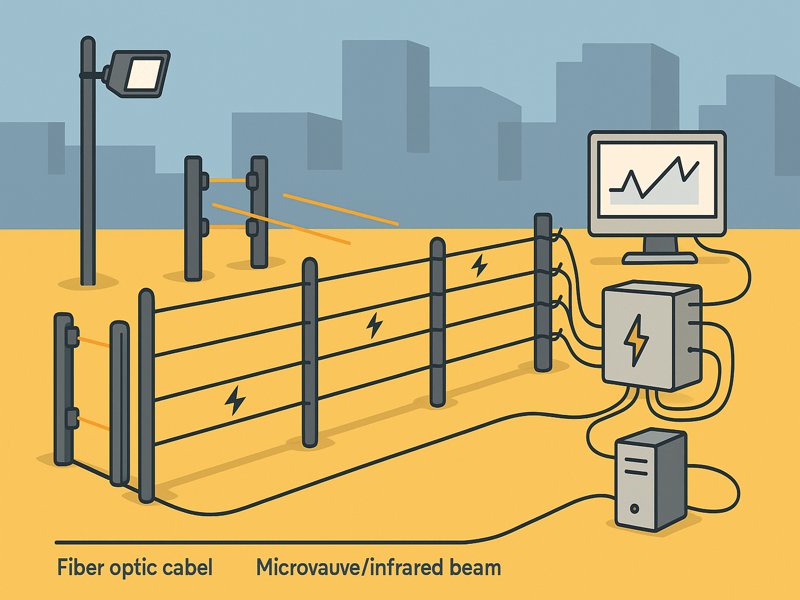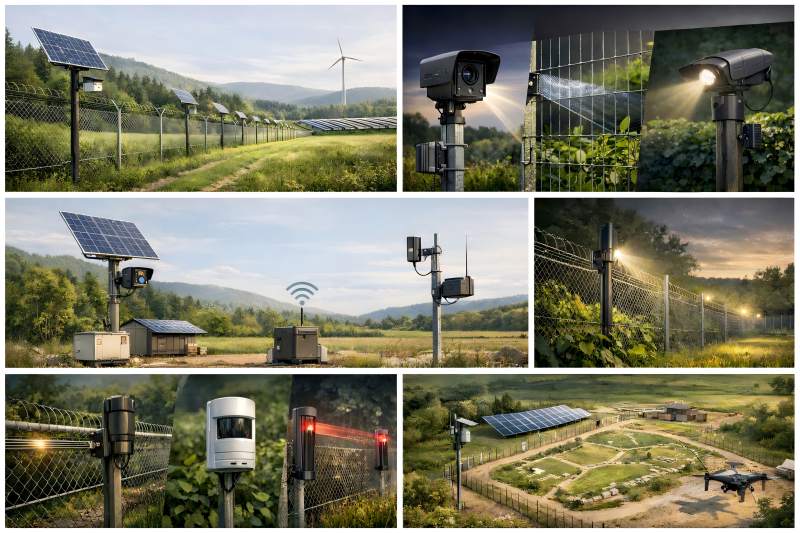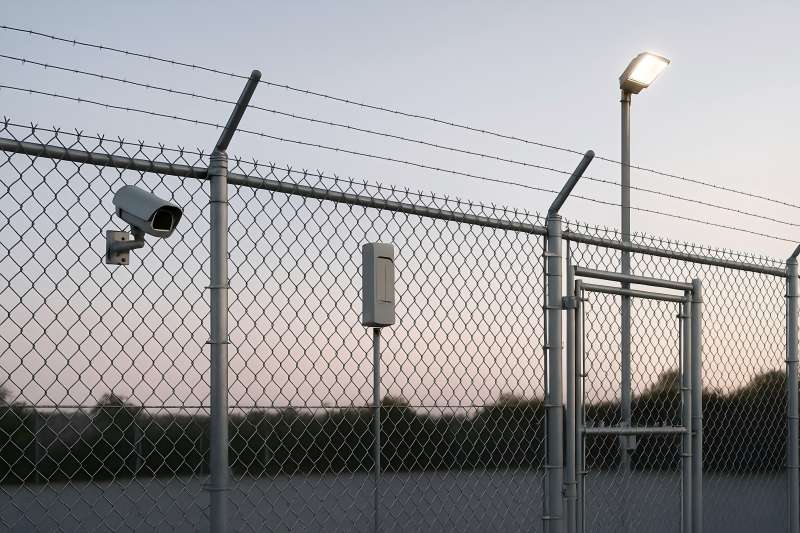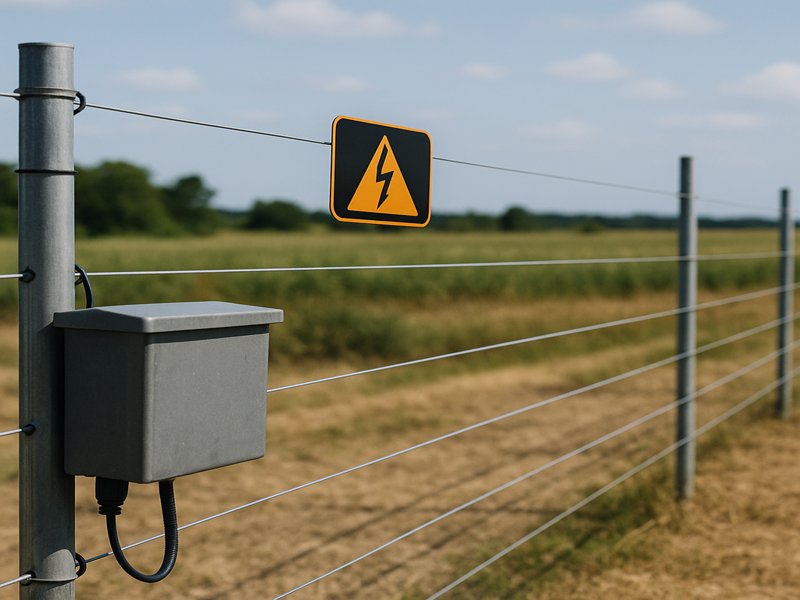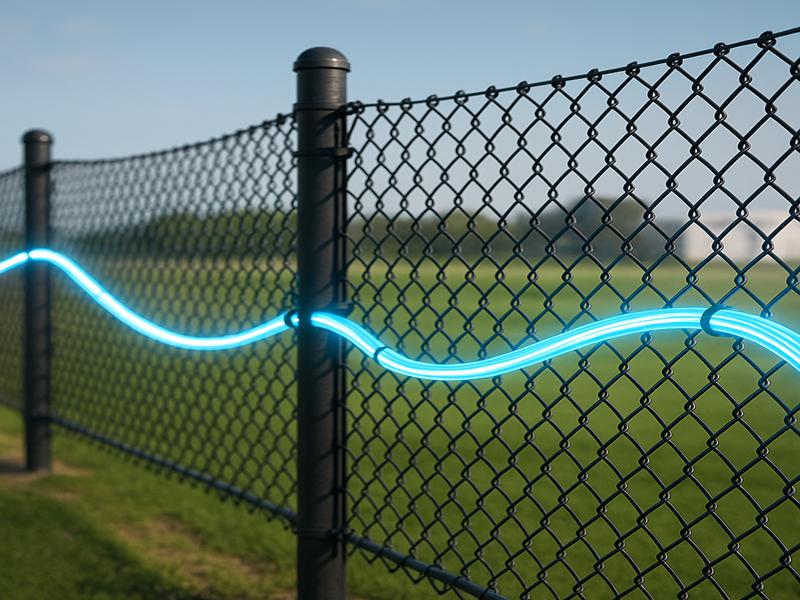Electric fence systems play a central role in sophisticated Perimeter Intrusion Detection Systems (PIDS), especially in high-security environments such as military bases, critical infrastructure, power plants, and border control zones. Combining deterrence with early detection, electric fences offer a powerful physical and electronic barrier that supports layered security strategies.
What is PIDS (Perimeter Intrusion Detection Systems)?
A security solution called a Perimeter Intrusion Detection System (PIDS) is made to identify, evaluate, and report any illegal attempts to cross a border that is secured border. These systems typically include multiple sensor types, such as:
- Fiber optic sensors
- Microwave and infrared beams
- Seismic detectors
- Electrostatic field sensors
- Electric fence sensors
PIDS can be deployed in a multi-layered approach, combining barriers, detection, and response systems to protect sensitive perimeters from intruders.
Electric fences serve both as a physical barrier and an active detection element within a comprehensive PIDS framework. Their ability to deter, detect, and delay intrusion attempts makes them a valuable component of high-performance perimeter security systems.
What Are Electric Fence Systems?
An electric fence system consists of an energized wire network that delivers a non-lethal, high-voltage pulse at regular intervals. Usually, the essential elements consist of:
- Power is transformed into high-voltage pulses by an energizer (power unit).
- Insulated wire strands: Carry the electrical charge
- Earth grounding rods: Provide a return path for the current
- Tensioners and support poles: Maintain wire integrity and stability
- Monitoring unit: Detects and reports abnormal changes such as cuts, shorts, or grounding
The person or thing that comes into contact with the energized wires receives a momentary electric shock. While not dangerous under normal operating conditions, this shock is painful enough to act as a powerful deterrent.
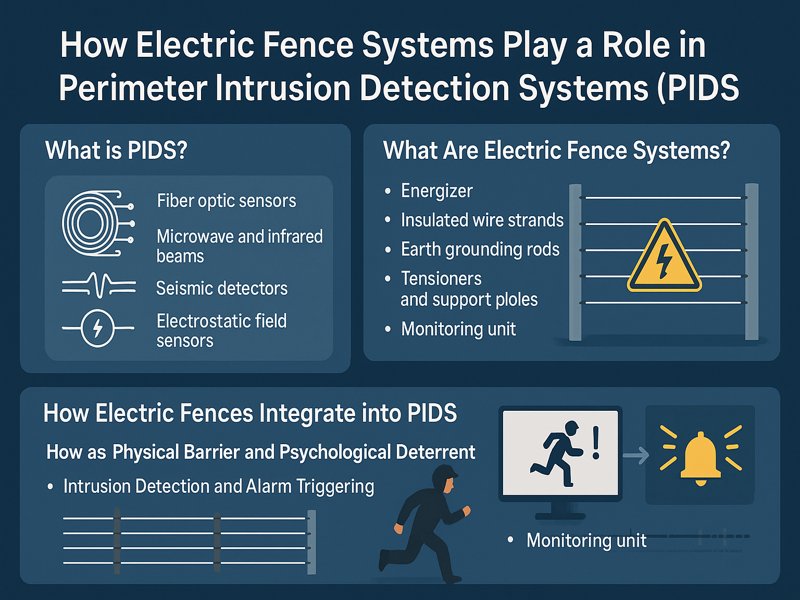
How Electric Fences Integrate into PIDS
Physical Barrier and Psychological Deterrence
Electric fences form the first line of defense by creating a visible and painful obstacle. The psychological deterrent—knowing the fence is electrified—discourages most intruders from even attempting a breach.
3.2 Intrusion Detection and Alarm Triggering
Modern electric fence systems are integrated with sensor technologies that detect:
- Voltage drops (due to grounding or wire cutting)
- Short circuits
- Line tampering
- Pressure or force on the wires
A central control system receives real-time alerts from these triggers and can subsequently:
- Log the intrusion attempt
- Trigger alarms or lights
- Notify security personnel
- Activate surveillance cameras
Electric fences can operate independently or alongside other PIDS elements, forming a layered detection matrix that increases reliability and reduces false alarms.
Applications of Electric Fence PIDS Solutions
Electric fences are deployed across a wide range of sectors, including:
| Sector | Use Case |
| Military and Defense | Border fencing, base perimeter security, arms depot protection |
| Power Plants | Nuclear facility fencing, substations, transformer yards |
| Airports and Seaports | Restricted area boundary detection, cargo terminal security |
| Industrial Zones | Oil refineries, chemical plants, logistics depots |
| Correctional Facilities | Containment of inmates and protection from external intrusion |
| Farms and Ranches | Livestock protection, rural perimeter fencing |
| Smart Cities | Integration with surveillance and automated response systems |
Each of these applications benefits from the deterrence, detection, and delay capabilities of electric fence systems integrated within a broader PIDS.
Key Features of Electric Fence Systems for PIDS
Non-Lethal Yet Effective Deterrence
Electric fences deliver safe, controlled shocks that are sufficient to deter but not harm humans or animals. This makes them suitable for urban, rural, and high-risk zones.
Real-Time Monitoring and Alerts
With continuous voltage monitoring and tamper detection, electric fences provide real-time feedback to control centers, enabling rapid response.
Scalability and Modularity
Electric fencing can be installed in modular configurations, from simple single-zone barriers to complex multi-zone grids integrated with CCTV and access control.
Environmental Resilience
Electric fences can operate in harsh weather and challenging terrains (desert, forest, snow, or marine environments) with proper grounding and insulation
Electric Fence System Design in a PIDS Network
Designing an electric fence for PIDS involves the following steps:
| Step | Description |
| 1 | Site survey: Assess terrain, perimeter length, and vulnerability points |
| 2 | Define zones: Divide the fence into logical alarm zones for better incident tracking |
| 3 | Select hardware: Choose energizer capacity, number of wires, sensor types |
| 4 | Integration: Connect with VMS, alarms, and control centers |
| 5 | Testing & calibration: Adjust voltage levels, sensitivity, and response thresholds |
Advanced systems also include dual-technology integration, combining electric fence detection with radar, seismic sensors, or AI-enhanced video analytics.
Advantages of Electric Fence Systems in PIDS
| Advantage | Explanation |
| Dual role | Acts as both a physical barrier and an intelligent sensor |
| Low false alarm rate | Less susceptible to wind, small animals, or weather than passive IR or microwave sensors |
| Immediate feedback | Voltage drop or tampering generates instant alerts |
| Deterrent value | Clear signage and painful shocks prevent unauthorized attempts |
| Low operating cost | Energy-efficient and with minimal maintenance once installed |
| High adaptability | Can be used on walls, fences, gates, rooftops, and stand-alone perimeters |
| Zonal monitoring | Security teams can quickly locate breach zones |
These advantages make electric fencing particularly appealing for critical infrastructure protection, where both active and passive deterrents are required.
Integration with Other PIDS Technologies
Electric fences can be integrated with several other PIDS layers, such as:
- CCTV Surveillance: Electric fence alarms can trigger camera movement and recording in a specific intrusion zone.
- Access Control Systems: Automatic gate locks can be activated in response to electric fence breaches.
- Alarm Management Software: Centralized platforms aggregate data from electric fences and other sensors for fast incident resolution.
- Radar/Seismic Sensors: Supplement fence data with buried sensors for cross-validation.
This multi-layer integration significantly improves detection accuracy and operational control.
Regulatory and Safety Considerations
While electric fences are non-lethal, they must comply with safety standards to protect personnel and the public. Key standards include:
- IEC 60335-2-76: International standard for electric fence energizers
- UL 69: North American safety standard
- National Electrical Codes: Regional compliance for installation, grounding, and energy levels
Proper signage is mandatory, and warning boards must be visible at regular intervals to prevent accidental contact.
Challenges and Mitigation Strategies
| Challenge | Mitigation Strategy |
| Grounding issues in dry or rocky soil | Use deeper or enhanced grounding techniques |
| Power supply outages | Integrate solar panels or battery backups for energizers |
| False alarms from vegetation or animals | Use pulsed current and calibrated force sensors |
| Vandalism or sabotage attempts | Use anti-tamper sensors and ruggedized wire materials |
| Environmental exposure | Weatherproofing, UV-resistant insulators, and corrosion-proof materials |
Proper installation and ongoing maintenance ensure long-term reliability and safety.
Case Study: Electric Fencing at a Border Control Site
In a recent deployment at a border surveillance project, electric fences were combined with fiber-optic cable sensors and CCTV. The system:
- Covered over 25 kilometers of remote terrain
- Included zone-based intrusion detection
- Reduced false alarms by 70% compared to passive IR-based solutions
- Enabled faster threat localization and automated camera activation
This illustrates the scalability and value of electric fencing in national-level PIDS solutions.
If properly designed and maintained, an electric fence system can provide robust protection within a multi-layered security system. As threats become increasingly sophisticated, the role of intelligent electronic fences in perimeter intrusion detection systems will continue to expand.
